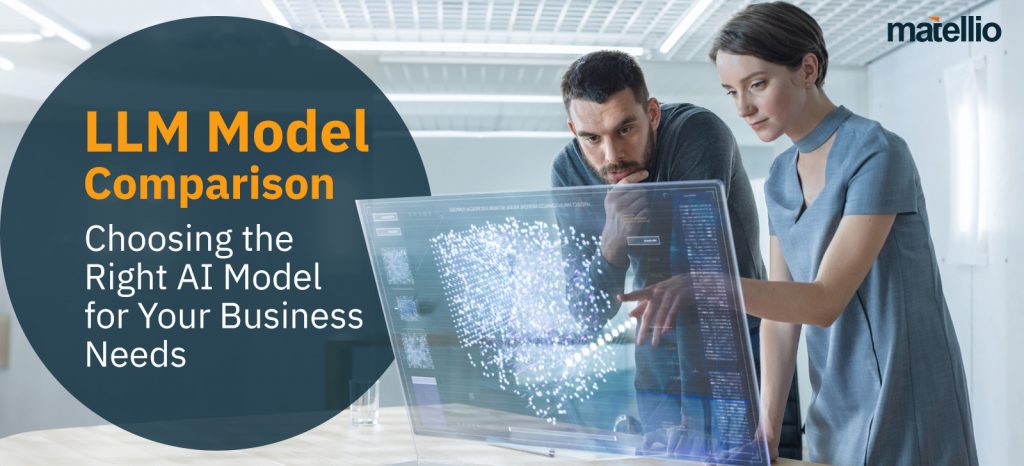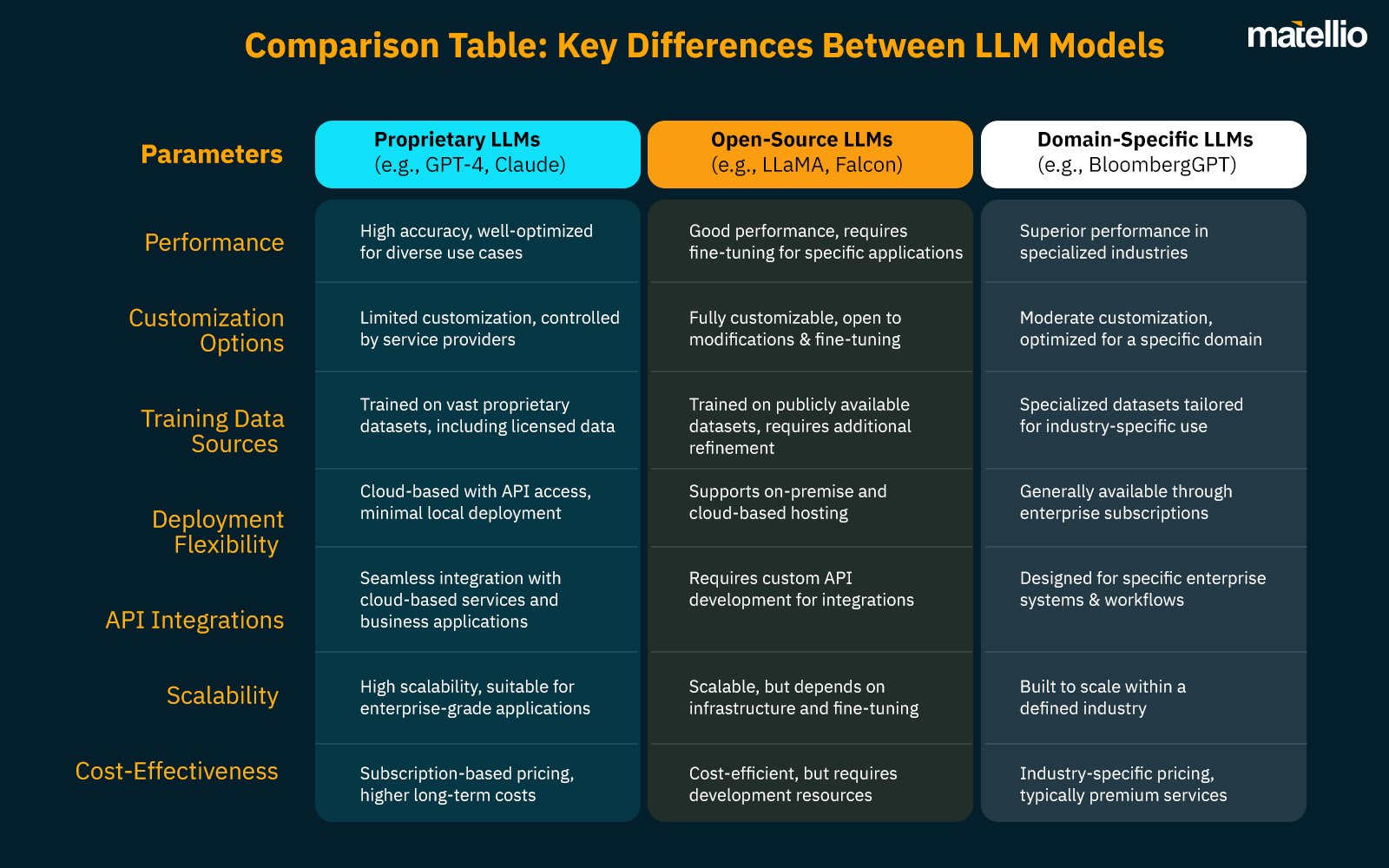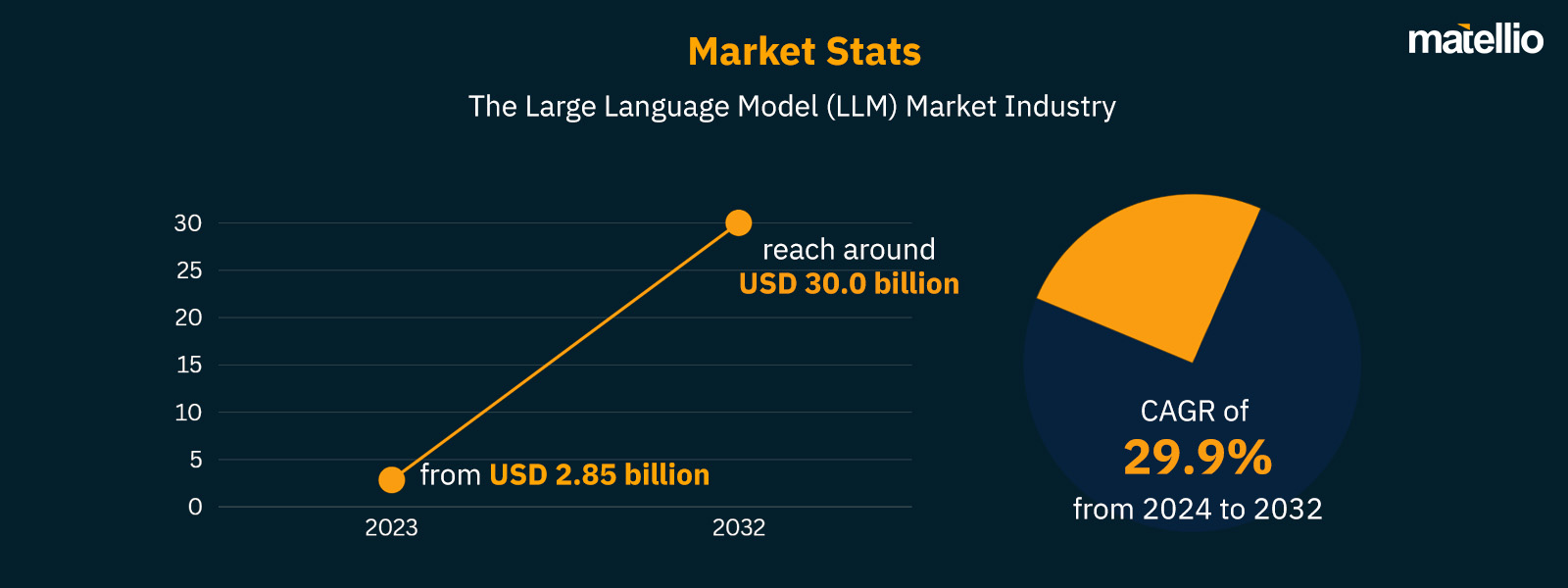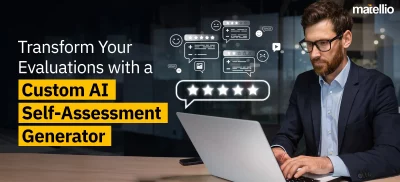
Large Language Models (LLMs) are transforming industries by driving automation, improving decision-making, and optimizing workflows with AI-driven capabilities. Businesses across sectors are leveraging LLMs for tasks like customer engagement, content generation, and data-driven insights. However, choosing the right model requires careful evaluation, as different LLMs vary in performance, scalability, and integration capabilities. A thorough LLM model comparison allows businesses to assess factors like cost, customization, and deployment options, ensuring they select the most suitable AI solution for their needs.
What Are LLM Models?
Large Language Models (LLMs) are advanced AI-powered models designed to process and generate human-like text by analyzing vast datasets. Utilizing deep learning techniques, these models excel in natural language understanding (NLU) and generation (NLG), making them highly effective for applications like content creation, chatbots, sentiment analysis, and automated decision-making.
LLM as a service is further revolutionizing business operations by offering scalable, cloud-based AI solutions that eliminate the need for complex infrastructure. This allows businesses to seamlessly integrate LLMs into their workflows, enhancing productivity, automation, and overall efficiency.
Source – Market Research Future
How Do LLM Models Work?
Understanding the underlying mechanisms of Large Language Models (LLMs) is crucial for businesses looking to leverage their capabilities for automation, decision-making, and customer engagement. LLM model comparison plays a significant role in selecting the right model for different business applications. Below is a breakdown of the core technical components that define how LLMs function.
 Transformer Architecture: The Foundation of LLMs
Transformer Architecture: The Foundation of LLMs
LLMs are primarily built on transformer models, an advanced neural network architecture designed for handling sequential data. Unlike traditional recurrent neural networks (RNNs), transformers process entire text sequences simultaneously rather than sequentially. This approach improves efficiency and allows models to understand long-range dependencies in language.
- Self-Attention Mechanism: LLMs use self-attention mechanisms to determine the relevance of different words in a sentence, allowing them to generate coherent and contextually relevant responses.
- Positional Encoding: Since transformers do not process text sequentially like RNNs, positional encoding is used to maintain the order of words within a sentence.
- Multi-Head Attention: This allows the model to focus on multiple aspects of input text at the same time, improving comprehension and accuracy.
By conducting comparison between LLM models, businesses can determine which transformer-based architecture best fits their operational needs.
 Deep Learning & Neural Networks: Powering Language Understanding
Deep Learning & Neural Networks: Powering Language Understanding
LLMs rely on deep learning techniques and vast neural networks to identify and analyze linguistic patterns. These models process text by breaking it into tokens, enabling them to generate highly contextual responses.
- Feedforward Neural Networks: LLMs use multiple layers of neural networks to refine text predictions and ensure logical consistency.
- Contextual Learning: Unlike earlier models that relied on word frequencies, LLMs understand context through layers of deep learning that capture relationships between words, phrases, and sentences.
- Generative Capabilities: By learning from extensive datasets, LLMs can generate original, human-like text, making them suitable for chatbots, content creation, and code generation.
A proper LLM AI comparison helps organizations select models with the best neural network structures to meet their business objectives.
 Training Process: How LLMs Learn from Data
Training Process: How LLMs Learn from Data
Training an LLM involves exposing it to vast amounts of structured and unstructured data, enabling it to understand and generate human-like responses. The process consists of several critical steps:
- Data Preprocessing & Tokenization: Text data is cleaned, formatted, and converted into numerical representations (tokens) that the model can process.
- Supervised & Unsupervised Learning: Some LLMs are trained on labeled data (supervised learning), while others learn patterns autonomously from large text corpora (unsupervised learning).
- Fine-Tuning & Reinforcement Learning: After initial training, models undergo fine-tuning with domain-specific data to improve accuracy. Reinforcement learning techniques, such as Reinforcement Learning from Human Feedback (RLHF), help refine responses by incorporating human evaluations.
Businesses looking for ML model development services can benefit from customized training approaches tailored to their industry-specific data.
 Cloud & API Integration: Deploying LLMs for Business Applications
Cloud & API Integration: Deploying LLMs for Business Applications
To enable businesses to harness LLM capabilities efficiently, cloud-based deployment and API integrations play a crucial role. Instead of requiring businesses to develop and maintain large AI models in-house, LLM service providers offer cloud-based APIs that simplify access and implementation.
- Cloud-Based Scalability: LLMs hosted on cloud platforms allow businesses to scale resources dynamically, ensuring optimal performance without requiring significant hardware investments.
- Real-Time API Access: Businesses can integrate LLM functionalities into their applications via APIs, allowing instant text generation, sentiment analysis, and automated decision-making.
- Customization & Fine-Tuning: Cloud-based LLMs enable businesses to customize models based on their industry-specific requirements, ensuring relevant and highly accurate outputs.
By conducting a LLM cost comparison, businesses can identify the most cost-effective solutions for their deployment needs.
 Performance Metrics & Model Evaluation
Performance Metrics & Model Evaluation
When comparing LLMs, businesses must assess performance across various parameters, including response accuracy, inference speed, and adaptability to industry-specific requirements. Some of the key evaluation metrics include:
- Perplexity Score: Measures how well an LLM predicts text sequences. Lower perplexity scores indicate better performance.
- Latency & Processing Speed: Determines how quickly an LLM generates responses, which is critical for real-time applications.
- Scalability & Deployment Efficiency: Evaluate how easily the model can handle increasing workloads in an enterprise environment.
A comparison of LLM models based on these factors helps businesses select the right solution that balances accuracy, efficiency, and cost-effectiveness.
Leverage LLM Models To Enhance Automation, Decision-Making, And Customer Engagement Large Language Models (LLMs) are reshaping industries by enhancing automation, improving efficiency, and driving innovation. Businesses across multiple sectors leverage these AI-powered solutions to optimize operations, streamline workflows, and personalize customer experiences. From LLM model comparison for selecting the best AI models to implementing real-time automation, LLMs are redefining how enterprises handle data and decision-making. Here’s how different industries are utilizing LLMs to gain a competitive edge. The healthcare industry is increasingly adopting AI-driven solutions to improve efficiency, accuracy, and patient outcomes. LLMs are transforming healthcare by automating administrative workflows, reducing human error, and assisting medical professionals in making data-driven decisions. Financial institutions are integrating AI-powered LLMs to automate fraud detection, optimize risk management, and streamline trading operations. These models enable financial firms to make informed, data-driven decisions. The telecom sector is integrating AI-powered LLMs to enhance customer service, optimize network performance, and improve predictive maintenance. Retail businesses are leveraging AI-driven solutions to personalize shopping experiences, automate operations, and optimize inventory management. LLMs play a crucial role in boosting customer engagement and enhancing sales strategies. The media industry is using AI-powered LLMs to automate content creation, improve ad targeting, and enhance user engagement. The manufacturing industry is leveraging AI-powered LLMs to optimize production efficiency, reduce downtime, and improve supply chain management. The SaaS and IT sectors are integrating LLMs to automate workflows, enhance cybersecurity, and improve software development processes, driving demand for SaaS development services. The travel industry is utilizing AI-driven LLMs to enhance booking experiences, optimize customer service, and provide personalized recommendations. The integration of LLMs across various industries is revolutionizing business operations, enabling automation, and improving decision-making. From healthcare diagnostics to automated trading and predictive maintenance, AI-driven solutions empower businesses to enhance efficiency and drive innovation. By leveraging AI integration services, companies can maximize the benefits of LLM technology and stay ahead in an AI-driven future. Selecting the right LLM model is essential for businesses aiming to leverage AI-driven automation and intelligence. Different models offer varying levels of customization, scalability, and deployment flexibility, making it crucial to align the choice with business goals. Below is an in-depth look at the various LLM models and their distinct advantages. Open-source LLM models provide businesses with unrestricted access to AI capabilities, allowing them to modify and optimize models based on their unique needs. These models are developed by the AI community and leading research organizations, making them freely available for customization and integration into enterprise solutions. Many organizations conduct an LLM model comparison to evaluate whether open-source models can deliver the desired performance while remaining cost-effective. Proprietary LLM models are developed and maintained by LLM service providers such as OpenAI, Google, and Microsoft. These models are fine-tuned using vast datasets and provide optimized AI-powered solutions through cloud-based services and APIs. Organizations evaluating LLM performance comparison often find proprietary models suitable for mission-critical applications requiring high accuracy and security. Domain-specific LLM models are trained in specialized datasets, catering to industries such as finance, healthcare, legal services, and manufacturing. Unlike general-purpose models, these AI solutions focus on industry-specific terminology, compliance standards, and operational requirements. When performing a comparison of different LLM models, companies in regulated sectors typically prefer domain-specific models for precision and compliance. Multimodal LLM models extend beyond text processing, allowing businesses to incorporate images, audio, and video into AI-powered applications. These models are widely used in industries requiring visual recognition, voice-enabled automation, and enhanced contextual understanding. A comparison between LLM models often shows that multimodal models are preferred for businesses seeking diverse AI-powered interactions beyond just text analysis. Cloud-based LLM models provide businesses with scalable AI capabilities without requiring significant IT infrastructure. These models are hosted on cloud platforms, allowing seamless API integration for real-time AI applications. Enterprises conducting an LLM cost comparison often choose cloud-based models for their affordability, flexibility, and ease of deployment. On-premise LLM models are deployed within an organization’s internal infrastructure, offering maximum data security and compliance. These models are ideal for businesses that require full control over AI processing, such as government agencies and financial institutions. Organizations conducting a comparison of large language models often prefer on-premise solutions when security, privacy, and compliance are the top concerns. Still Comparing LLM Models? Let Our AI Experts Guide You in Selecting the Best Fit for Your Needs! While LLM models provide immense value across industries, their implementation presents multiple challenges that businesses must address for effective adoption. Organizations looking to leverage these models must navigate issues related to computational costs, security, ethical considerations, and scalability to ensure long-term success. Implementing LLM models requires substantial computational power, leading to high infrastructure and operational expenses. Businesses need high-performance GPUs or TPUs, which add to deployment costs, especially when training models in-house. Cloud-based AI solutions offer scalability, but the expenses can quickly add up. Solution: Organizations can mitigate costs by exploring LLM cost comparison options and adopting cloud-based AI solutions that provide flexible, pay-as-you-go pricing. Leveraging optimized model architectures and reducing unnecessary computations can also lower expenses. Handling sensitive business and customer data requires strict adherence to global data privacy laws. Compliance with GDPR, HIPAA, and CCPA is essential to prevent regulatory penalties and ensure secure data handling. Unauthorized access or breaches can compromise proprietary business intelligence. Solution: Implementing business intelligence services with secure AI-driven analytics ensures encrypted data processing and compliance with industry regulations. Advanced security frameworks, access controls, and real-time monitoring can prevent data breaches. Customizing LLM models for industry-specific applications involves fine-tuning with specialized datasets. However, this requires a deep understanding of AI model training, extensive labeled datasets, and rigorous validation processes to ensure accuracy. Solution: Engaging with LLM development services that specialize in model fine-tuning can help businesses optimize their AI solutions without the complexities of in-house customization. Transfer learning techniques and pre-trained domain-specific models can also accelerate fine-tuning. Many LLM models have inherent biases from their training data, which can lead to ethical concerns and incorrect decision-making. This issue is particularly crucial for sectors like finance, healthcare, and recruitment, where AI-generated insights influence major business outcomes. Solution: Businesses should conduct AI LLM comparison research to identify models with better bias mitigation techniques. Implementing fairness-aware algorithms, human-in-the-loop AI and continuous bias audits can improve ethical AI deployment. Many enterprises operate on legacy systems that are not AI-ready, making LLM integration services a crucial challenge. Compatibility issues, lack of API support, and outdated infrastructure can slow down AI adoption. Solution: Businesses should choose LLM service providers that offer flexible API-based integrations with existing systems. Middleware solutions and cloud-hosted AI infrastructures can bridge the gap between legacy applications and AI-powered automation. As business operations scale, LLM models must handle increasing data volumes, diverse queries, and real-time processing requirements. Poor scalability can lead to slow response times, high latency, and degraded model performance. Solution: Companies should conduct an LLM performance comparison before selecting a model to ensure it meets scalability requirements. Deploying AI on cloud-based infrastructures with dynamic scaling, caching mechanisms, and model optimization techniques can improve performance under heavy workloads. Deploying LLM models for natural language understanding presents challenges in contextual comprehension, ambiguity resolution, and language adaptation. Business-specific terminology and domain-specific language structures may require additional fine-tuning. Solution: Leveraging NLP services with domain adaptation capabilities ensures improved contextual understanding in AI models. Businesses can enhance accuracy by training models on industry-relevant datasets and implementing AI-powered language models that adapt to business-specific nuances. Selecting the right LLM model is a critical decision that requires businesses to consider multiple factors, including objectives, data requirements, scalability, deployment models, and cost efficiency. A well-structured approach ensures that the model aligns with business goals and delivers optimal performance while maintaining compliance and security. Below are the essential steps businesses must take when choosing an LLM model. Before implementing an LLM model, businesses must establish clear objectives that define its purpose and expected outcomes. Whether it’s enhancing customer service, automating content generation, optimizing workflows, or improving predictive analytics, understanding the primary goal ensures the selection of a model that meets specific business needs. With expertise in enterprise software development services, we help businesses assess their unique AI use cases and define strategies to maximize the impact of LLM solutions. Our team ensures that the model selection aligns with business objectives, driving efficiency and innovation. Data is the foundation of an LLM model, and its effectiveness depends on the quality, quantity, and accessibility of relevant datasets. Businesses must evaluate their existing data sources, ensure proper structuring, and confirm compliance with data privacy laws like GDPR and HIPAA. The right data strategy minimizes biases, enhances model accuracy, and ensures ethical AI implementation. Our LLM integration services enable businesses to optimize data handling processes while ensuring that AI models are trained with high-quality and regulatory-compliant datasets. We assist in integrating AI models with secure, structured data pipelines for maximum performance. As business operations grow, the selected LLM model should be able to handle increasing data loads and processing requirements without compromising speed or accuracy. Scalable AI solutions enable businesses to expand their AI capabilities over time without the need for frequent retraining or system overhauls. Our team conducts a thorough LLM performance comparison, helping businesses select AI models that maintain processing efficiency even as data volumes and operational complexities increase. We ensure seamless scalability to accommodate future growth. Different industries require AI models tailored to their unique needs. While some LLM models are pre-trained for general use, others allow fine-tuning with industry-specific datasets, making them ideal for applications in healthcare, finance, retail, and more. Customization ensures greater accuracy, relevancy, and alignment with industry regulations. Our LLM development services support businesses in fine-tuning AI models to suit their operational requirements. Whether it’s developing industry-specific prompts, adjusting response generation, or optimizing AI workflows, we help businesses achieve high-value AI solutions. Businesses must decide between cloud-based, on-premise, or hybrid LLM models based on security, performance, and cost considerations. While cloud solutions offer accessibility and flexibility, on-premise deployments provide greater control over data privacy and security. Through our digital transformation services, we help businesses choose the right deployment strategy by evaluating operational needs, compliance requirements, and existing IT infrastructure. Our team ensures seamless integration with business workflows, optimizing accessibility and performance. The investment in an LLM model includes licensing, infrastructure, training, and maintenance costs. Businesses should conduct a thorough cost-benefit analysis to understand the long-term ROI and ensure that the solution delivers tangible value. Choosing a cost-effective yet high-performing model is essential for sustainable AI adoption. With our LLM cost comparison services, we help businesses evaluate different pricing models, licensing agreements, and operational costs to identify the most budget-friendly and high-value AI solution. Our goal is to maximize cost efficiency while ensuring top-tier performance. Since LLM models process vast amounts of sensitive data, businesses must prioritize security measures like encryption, access control, and regulatory compliance to prevent breaches and maintain customer trust. Ensuring that AI-generated insights align with ethical AI principles is crucial. Our services integrate AI-driven solutions with robust security frameworks, ensuring end-to-end data protection and compliance with international regulations. We help businesses implement risk mitigation strategies for secure AI adoption. Upgrade Your AI Capabilities with Next-Gen LLM Integrations. As businesses increasingly adopt LLM models for automation, decision-making, and customer engagement, the landscape is evolving with transformative advancements. The future of LLM model comparison will focus on improving efficiency, security, and adaptability, making AI solutions more reliable and industry specific. Below are the key trends shaping the next phase of LLM adoption. Personalization is becoming a top priority for businesses implementing AI solutions. Future LLM comparisons will emphasize models that can analyze user behavior and dynamically adjust interactions to provide highly customized responses. Whether in customer support, marketing automation, or content generation, businesses will increasingly prioritize LLMs that enhance engagement through adaptive learning. Traditional LLMs primarily process text, but future advancements will introduce multimodal capabilities, enabling AI to analyze and interpret text, voice, images, and videos simultaneously. Businesses evaluating LLM comparisons will seek models that integrate diverse data sources, allowing for a more holistic approach to AI-driven automation. This evolution will benefit industries like healthcare, media, and retail, where AI must interpret multiple types of user inputs. The reliance on cloud infrastructure for LLM model comparison has raised concerns about latency, security, and cost. The emergence of Edge AI allows businesses to process AI tasks on local devices rather than relying solely on cloud computing. This trend will significantly impact enterprises adopting AI-powered automation, reducing response times and enabling faster decision-making while improving data security. The demand for industry-tailored AI models is growing, pushing businesses to invest in customized AI solutions rather than relying on general-purpose LLMs. Companies looking at comparison of different LLM models will focus on selecting AI solutions that align with sector-specific regulations, workflows, and data handling practices. Industries like finance, legal, and manufacturing will require AI models that specialize in compliance-driven and context-aware automation. With increasing concerns over AI bias, security, and ethical implications, regulatory bodies worldwide are introducing stricter governance policies for AI models. Businesses evaluating LLM integration services must ensure compliance with data privacy laws, ethical AI frameworks, and security standards. Future AI models will integrate bias detection, transparency features, and audit trails, ensuring accountability and ethical AI implementation. Many enterprises are assessing LLM cost comparison to ensure they invest in cost-effective AI models without compromising performance. The trend toward subscription-based AI models and pay-as-you-go pricing will make AI solutions more accessible to businesses of all sizes. Companies will prioritize LLM models that provide high accuracy with minimal infrastructure investments, ensuring sustainable AI adoption. Additionally, ChatGPT integration & consulting services are gaining traction as businesses seek expert guidance to fine-tune AI deployments, maximize efficiency, and customize models to meet specific operational needs. Implementing LLM AI-powered solutions requires deep expertise, strategic integration, and ongoing optimization to ensure seamless performance and business impact. Matellio specializes in LLM development services, helping businesses harness the power of language models for automation, content generation, and data-driven decision-making. Below are key areas where our experts support LLM model implementation: If you’re ready to transform your business with LLM-powered AI solutions, fill out the form today get started with expert guidance from Matellio! Each LLM model varies in terms of architecture, training data, performance, and customization capabilities. Businesses must conduct a comparison of LLM models to determine which aligns best with their needs. A structured evaluation process, including LLM comparisons, scalability analysis, and industry-specific fine-tuning, helps businesses select the most effective model for their use case. Costs vary based on factors like model complexity, deployment method, and API integrations. Businesses should conduct an LLM cost comparison to assess affordability and long-term ROI. Yes, businesses can work with LLM service providers to fine-tune models using domain-specific datasets, ensuring accurate and contextually relevant results for their industry. Data protection is essential when using AI models. Implementing encryption, role-based access, and compliance frameworks ensures security in LLM AI comparison implementations. Use Cases of LLM Models in Different Industries
 Healthcare
Healthcare
 Finance
Finance
 Telecom
Telecom
 Retail
Retail
 Media & Entertainment
Media & Entertainment
 Manufacturing
Manufacturing
 SaaS & IT Industry
SaaS & IT Industry
 Travel & Hospitality
Travel & Hospitality
Final Thoughts

Types of LLM Models
Open-Source LLMs
Advantages:
Proprietary (Commercial) LLMs
Advantages:
Domain-Specific LLMs
Advantages:
Multimodal LLMs
Advantages:
Cloud-Based LLMs
Advantages:
On-Premise LLMs
Advantages:
Challenges in Implementing LLM Models for Businesses
High Computational Costs
Data Privacy & Security Concerns
Fine-Tuning Complexity
Bias & Ethical Considerations
Integration with Legacy Systems
Scalability & Performance Issues
NLP Challenges in Business Applications
Steps to Choose the Right LLM Model for Your Business
 Define Business Objectives
Define Business Objectives Assess Data Requirements
Assess Data Requirements Consider Scalability Needs
Consider Scalability Needs Evaluate Customization Capabilities
Evaluate Customization Capabilities Assess Deployment Flexibility
Assess Deployment Flexibility Compare Cost & ROI Impact
Compare Cost & ROI Impact Ensure Security & Compliance
Ensure Security & ComplianceFuture Trends in LLM Model Development & Adoption
AI-Powered Personalization
Multimodal LLMs
Edge AI & Decentralized Computing
Industry-Specific LLMs
Stronger AI Regulation & Compliance
Cost Optimization in LLM Adoption
How Matellio Can Help with LLM Model Implementation?
LLM Model Comparison – FAQ’s
Q1. What is the difference between different LLM models?
Q2. How do I determine which LLM model suits my business?
Q3. What are the costs associated with implementing an LLM model?
Q4. Can LLM models be fine-tuned for industry-specific applications?
Q5. What security measures should businesses take when using LLMs?

 Transformer Architecture: The Foundation of LLMs
Transformer Architecture: The Foundation of LLMs Deep Learning & Neural Networks: Powering Language Understanding
Deep Learning & Neural Networks: Powering Language Understanding Training Process: How LLMs Learn from Data
Training Process: How LLMs Learn from Data Cloud & API Integration: Deploying LLMs for Business Applications
Cloud & API Integration: Deploying LLMs for Business Applications Performance Metrics & Model Evaluation
Performance Metrics & Model Evaluation

